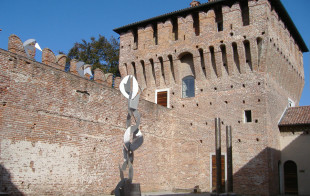The Territory of Novara
Mirrors of water, roads running between green fields and cultivated fields, dotted with farmhouses that have now disappeared or converted into historic residences. There are many suggestions of colors that combine the perfumes of the products of this territory, unusual and unveiled.
A territory to be discovered
Small villages, large castles, lakes and mountains reveal the great beauty of the surroundings of Novara and the region. An unforgettable experience for everyone.

Momo – The Holy Trinity Church
Not far from the center of the village, along the regional road no.229, stands the oratory of the Holy Trinity. This place was already considered sacred by the Celts. The oratory was originally built around the twelfth century but was mentioned for the first time only in 1347. The oratory rose to accommodate pilgrims traveling via Francigena via the alpine passes of the Ossola to the main directions. Of great value are the frescoes dating to the 15th and 16th centuries, attributed to the Cagnola shop, depicting scenes of Christ’s life.
Galliate – Visconteo-Sforzesco Castle
The castle assumed its present features in 1476 for the will of Galeazzo Maria Sforza, who intended to make the building a comfortable residence for the hunting lodges of the Milan court. In 1532 it became a feud of the Caravaggio degli Sforza branch, undergoing several transformations in the seventeenth century. During the 17th century, the Marchesa Maria Aldobrandini Sforza made the frescoes that are still visible in the castle today. Today it is largely municipal property and hosts the Achille Varzi Museum Room and the Museum of Contemporary Art Angelo Bozzola. The building regularly hosts exhibitions and exhibitions.


Carpignano Sesia – Ricetto Castle and San Pietro in Castrum Church
The first news on the castle dates back to the twelfth century, but its origins are more ancient, as evidenced by the church of St. Peter, built at the beginning of the 11th century. By the middle of the 12th century it was donated to the Benedictine Order of Cluny, thus becoming part of a true network of churches, priests and abbeys extended to all Western Europe. Inside the church the largest apse frescoes dating from 1140 to 1159 are a true treasure of the panorama of Romanesque Poetry painting for the high pictorial level and the dense iconographic contents.
Galliate – Varallino Sanctuary
Dedicated to the Virgin’s Nativity, it was built at the end of the 16th century by Pellegrino Tibaldi. The name of the sanctuary is due to its internal resemblance to the Sacred Mount of Varallo. The statues and frescoes of the Crucifixion Group are to be called “pittor divoto” by Lorenzo Peracino, as well as the fresco decoration of the two sacristies and the dome depicting Paradiso, where about 300 characters were depicted in a turbine of divine light.


Oleggio, San Michele
The church dedicated to San Michele lies within the cemetery of Oleggio. Cited in the 10th century, the current building dates back to the X-XI century. The interior, with a wooden roof covering, preserves valuable frescoes from medieval times, among the few examples of Romanesque art still visible in Northern Italy. In the apsidal cathedral is depicted the Christ in Majesty with figures of deacons and knights; while on the counterfed is a great Universal Judgment. Other frescoes dating back to the late 15th and early 16th centuries are located along the main aisle.
San Nazzaro Sesia – Santi Nazzari and Celso’s Abbey
It is the most important fortified abbey complex of Novarese and one of the most significant in northern Italy. Founded in 1040, the bishop of Novara Riprando, belonging to the prestigious family of Counts of Biandrate, the plant was fortified from the 13th century. Subsequently, during the fifteenth century, it was expanded and reconstructed. Noteworthy is the church, whose façade is a significant example of Lombardy Gothic architecture, and the cloister, portico on the four sides, enriched by the late 15th century fresco cycle of unknown author, representing a hundred episodes, many of which are well preserved , of the life of St. Benedict from Norcia.




